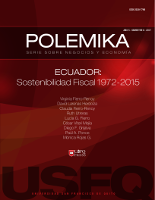Brechas de Infraestructura en Ecuador: Una Estimación Basada en un Modelo VEC
Contenido principal del artículo
Resumen
En este artículo estimamos la brecha vertical de infraestructura en Ecuador para los sectores de transporte y energía durante el periodo 1967-2015. Para ello, utilizamos un análisis de cointegración basado en un modelo VEC. La brecha se ha reducido significativamente durante este periodo, llegando a su mínimo en el año 2015, cuando representó el 16.8% del PIB, es decir, cerca de US$ 17 mil millones. Adicionalmente, realizamos un análisis de la inversión en infraestructura económica por etapa presupuestaria para el periodo 2008-2016. Esta inversión ha sido altamente procíclica con una alta presión para incrementar el gasto tanto entre etapas presupuestarias como entre presupuestos. En base a esta evidencia concluimos que los principales retos de la inversión en infraestructura económica en Ecuador son: en el corto plazo, la falta de recursos que el país enfrenta y, en el largo plazo, la incapacidad para generar inversión sostenible evitando la prociclicidad.
